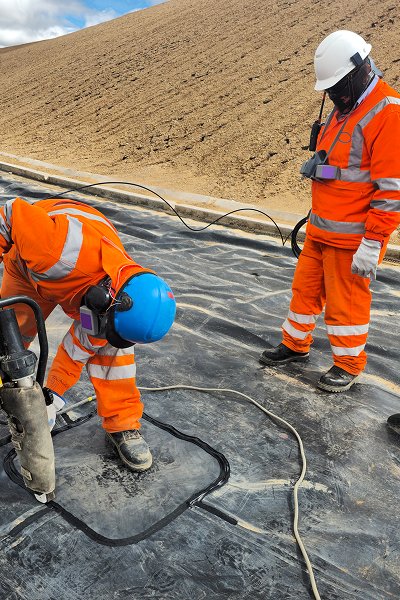Basic structure of GCL
The standard Geosynthetic Clay Liner structure usually includes three layers:
Upper geotextile: usually non-woven geotextile is used to protect the clay layer and enhance the overall strength;
Middle bentonite: high-swelling sodium-based bentonite particles or powders are selected, which have strong water absorption and swelling ability to form a closed waterproof barrier with low permeability;
Lower geotextile or geomembrane: plays a supporting and reinforcing role. Some products use HDPE membrane in the lower layer to improve chemical stability and corrosion resistance.

Overview of GCL's advantages and characteristics
Ultra-low permeability: The hydrated bentonite layer forms a natural sealing barrier;
Convenient construction: GCL is a prefabricated material, easy to transport, fast to lay, and suitable for large-area coverage;
Strong self-healing ability: When there is local damage, the bentonite can automatically seal the cracks after expansion;
Space saving: The thin layer design can reduce the thickness of the landfill cushion layer and increase the storage capacity;
Good compatibility: It can be used in combination with HDPE membranes, geotextiles and other materials to build a composite anti-seepage system;
Environmentally friendly and sustainable: Natural bentonite materials are friendly to the ecological environment and do not release pollutants.
The most important protective barrier of a landfill is located at the bottom of the site, mainly used to prevent leachate from seeping down and polluting the groundwater system. As part of the bottom lining, GCL is usually used in combination with HDPE membrane or other geomembrane materials to construct a "membrane-pad" dual protection structure:
The first barrier: HDPE geomembrane, used to prevent direct liquid leakage;
The second barrier: GCL, using bentonite to swell with water to form a low permeability layer. Even if the membrane is perforated, GCL can close the hole through swelling and achieve "self-healing".
This composite system is called the Composite Liner System, which is the standard configuration of the bottom liner of most modern landfills.
The functions of GCL in this system include:
Supplementing the anti-seepage weaknesses of HDPE membrane (such as puncture points and welds);
Absorbing small foundation settlements without breaking;
Simplifying the construction process and improving construction efficiency.
CL's flexible adaptability in slope and corner areas
Landfills are often built in complex terrain areas, especially in sidewall slopes and boundary corners, where the terrain is undulating and the laying space is limited. In these areas, rigid anti-seepage materials (such as concrete or thick clay) are often difficult to adapt or prone to breakage.
GCL has the following advantages:
Strong flexibility: can adapt to irregular terrain;
Good ductility: no obvious joints when laying in complex areas such as slopes and corners, reducing the risk of leakage;
Convenient construction: rolled materials can be rolled quickly, especially suitable for steep slopes and height difference areas.
GCL's role in promoting environmental protection
From an environmental protection perspective, the application of GCL directly improves the environmental safety of landfills, mainly in the following aspects:
Reducing the migration of toxic substances;
Reducing damage to surrounding groundwater, soil and vegetation;
Extending the service life of landfills;
Reducing long-term environmental governance costs.
The functions of GCL in landfills are multifaceted and comprehensive. Whether as the main anti-seepage material at the bottom, as a component of the top sealing system, or as a flexible protective material for complex slopes and corner areas, GCL has won wide application for its high efficiency in anti-seepage, self-healing ability, and ease of construction. It has become an important technical means to improve environmental safety and optimize construction efficiency in landfill projects.


